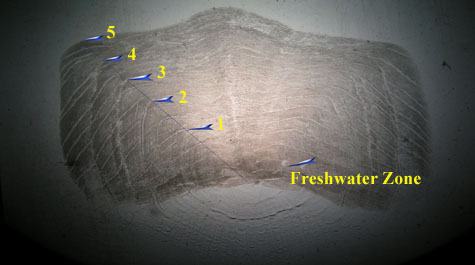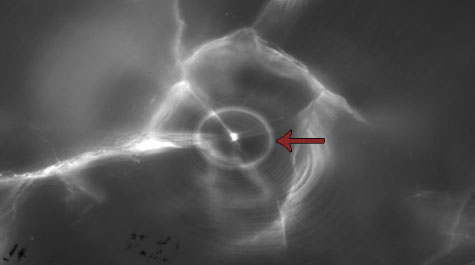Fish Processing and Analysis
Biological Data
All adult American shad and river herring collected are weighed and measured using an electronic fish measuring board. Measurements from the board are recorded and stored in a data file for later analysis. Every fish is measured for: fork length, total length, sex, gonad stage and weight. Scales are taken from each fish to be used for age determination and spawning histories. Otoliths (ear bones) are also taken from adults to be scanned for hatchery marks and used for age determination.
Ageing Scales

Scales are removed from the mid-lateral area just below the dorsal fin on the left side of each fish. Scales are soaked in water and scrubbed to remove any debris that can interfere with reading. Several scales from each fish are mounted on a 3" x 5" acetate sheet. The sheets are then pressed in a heated hydraulic press. The scales are removed from the sheet, leaving an impression of the scale. The sheets are then read on a microfilm projector to determine the age and spawning history. Fish scales have annual rings or annuli, much like the rings on a tree. By counting these marks scientists can determine the age of the fish. Scales are also used to count spawning marks, which determine how many times a fish has spawned.
Otolith Scanning
From 1992 -2017 the Virginia Department of Wildlife Resources (DWR) and the US Fish and Wildlife Service (USFWS) conducted a hatchery-restocking effort on the James River. Adult shad from the Pamunkey River were used as brood stock; eggs were stripped and fertilized in the field. The larvae are then reared in DWR and USFWS hatchery facilities. After the fry hatched they are immersed in an oxytetracycline (OTC) solution that marks the otoliths with a distinctive epi-fluorescent ring. This allows scientists to distinguish hatchery fish from wild stocks. 
To scan for hatchery marks, otoliths are mounted on slides then carefully ground and polished using wet laboratory-grade sandpaper. This is very delicate work; the otoliths can easily be cracked or broken. Once both sides of the otolith have been ground they can be read using an epi-fluorescent microscope. When the otolith is exposed to fluorescent light the OTC mark will appear as a bright ring.

